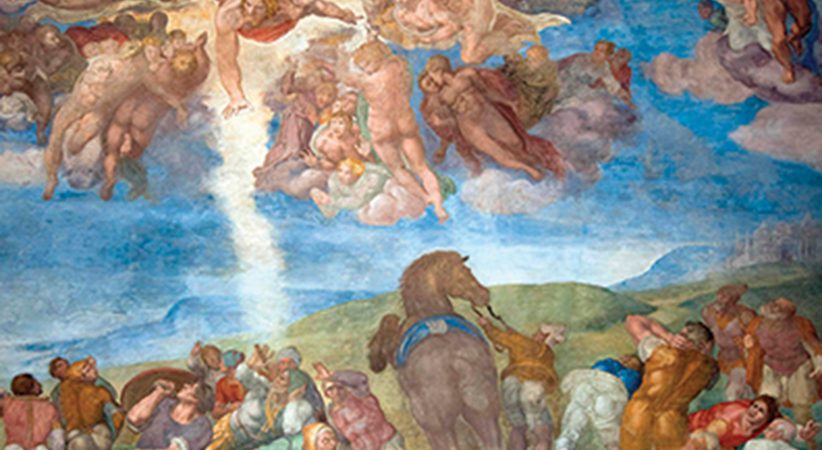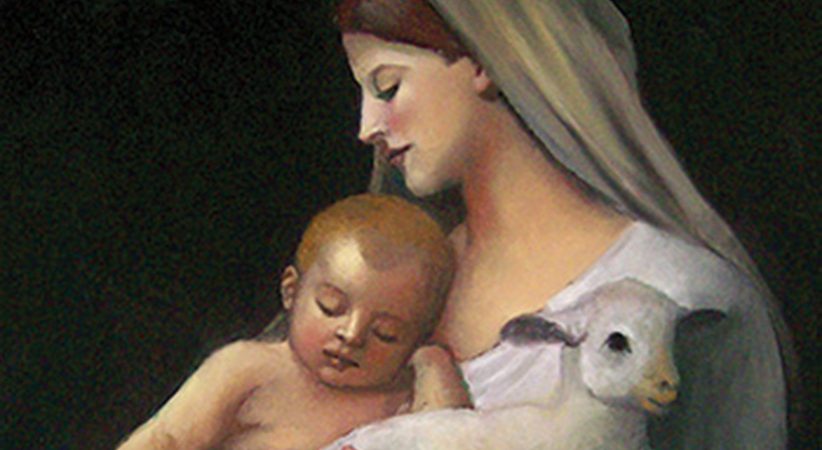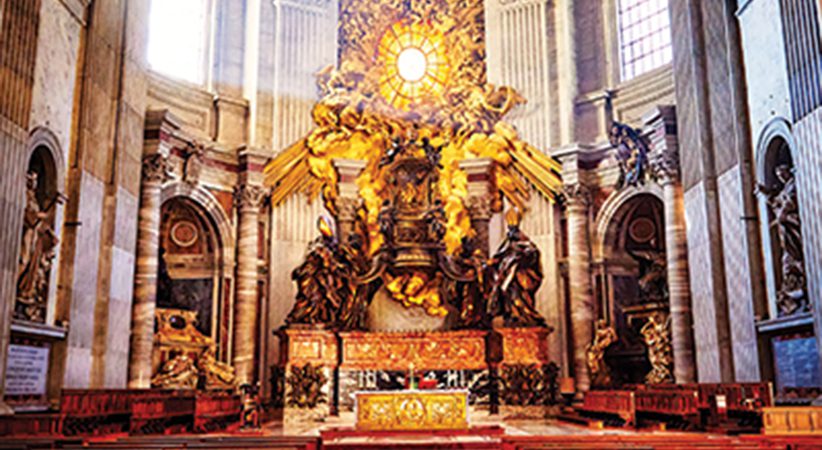Pour Out a Spirit of Compunction
Acknowledging that we fall short
Father Adrian Burke Comments Off on Pour Out a Spirit of Compunction
“Pour out a spirit of compunction, O God, on those who bow before your majesty, and by your mercy may they merit the rewards you promise to those who do penance. Through Christ our Lord. Amen.”
This is the prayer over the people for Mass on Ash Wednesday. It serves to remind the faithful that the liturgical season of Lent is a sacred time for the Church, a time to renew our commitment to personal conversion. Lent is a season during which we focus on the need to be reconciled with God and one another, and to recenter on our vocation to holiness by allowing God’s grace to pierce our hearts with a “spirit of compunction.”
The committed follower of Jesus yearns with a holy desire for eternal life and to receive the grace needed to “merit the rewards you [God] promise to those who do penance.” Repentance is, in a sense, the engine of conversion — a change of mind and heart (Greek metanoia) — fueled by a desire to be conformed to Christ. The Ash Wednesday Prayer over the People reminds us that “merit” is accomplished through Christ, and is realized only in Christ, for it is Christ’s sacrifice that redeems. Our Father, at his Son’s behest, pours out on us the Holy Spirit, “called to our side” (Greek Parakletos), for the forgiveness of sins. We have not been left “orphans”!
Stabbing Awareness
One of the most important graces bestowed on his Church while “on the way” is a spirit of compunction. Endowed with faith in God, understanding that we humans are creatures and not God, we stand before the Creator in profound awe of God’s omnipresent and omniscient majesty — that is the fear of the Lord. By the light of faith and holy fear, we acknowledge that we often fall short of our calling to be images of God. This stance in truth before God is the basis of Christian humility, an awareness of our sinful condition that arouses the heart to desire conversion, repentance and forgiveness. It’s what St. Peter experienced when he heard the cock crow after denying three times that he knew Jesus and then recalled the words the Lord spoke to him while at supper (cf. Lk 22:61). That “stab” of awareness must have been painful indeed.
Edna Hong, an American writer, poet and committed Christian, wrote that the purpose of Lent is to arouse in the faithful a sense of sin, an awareness of personal responsibility for how our sins contribute to systemic patterns of worldly injustice. The Canticle of Zechariah from Luke’s Gospel, recited daily as part of our morning offering, reminds us that the forgiveness of sins is the basis of human redemption: “And you, child, will be called prophet of the Most High, / for you will go before the Lord to prepare his ways, / to give his people knowledge of salvation / through the forgiveness of their sins” (Lk 1:76-77).
The paschal mystery of Our Lord is meant to redeem us by healing the breach between humanity and God that was caused by sin and our idolatrous tendencies to remake God in our image and likeness; in contrast, we should be “bowing before God’s majesty” and striving to be who God intends us to be. The passion and death of Jesus is for the forgiveness of sins, but for forgiveness to be realized and effect the reconciliation (and salvation) we hope for, we must be aware of our need for God’s mercy and thus receptive to the grace of God’s forgiveness. At Easter, we celebrate Christ’s victory over sin, but to fully rejoice in Christ’s victory we must receive this great gift as our own victory, too. This graced reception begins with a spirit of compunction, a sense of responsibility for our sins, and ends in a reconciled communion with God and neighbor — the ground of our true selves in Christ.
Saints on Compunction
The word compunction isn’t heard very often these days in Bible study groups or Theology on Tap gatherings or, even, dare I say, in homilies at Mass. To clarify a bit more what is meant by the term, I draw from two of the Church’s great saints. In his “Confessions,” St. Augustine describes his experience of compunction as “a broken and contrite heart.” He calls it a gift from God that “pierces the heart with sorrow for sin” and leads to repentance and forgiveness. Compunction connotes being “stung” at heart (Latin compungere, meaning “to prick hard” or “to sting”). What stings is the realization that one has missed the mark through behavior that falls short of truth, actions contrary to our calling. Augustine notes that compunction is accompanied by tears of remorse, which are signs of God’s mercy and healing.
St. Thomas Aquinas was inspired by Augustine when he wrote “De Contritione,” a treatise on the virtue of penance in which he describes compunction as “a movement of the will,” by which one abhors sins committed. Aquinas writes that compunction is necessary for contrition, which is “sorrow of the soul and detestation for sin committed, together with the resolution not to sin again.” Aquinas acknowledges that compunction is a gift of God — a spirit poured out on us, as in the prayer from Ash Wednesday — that moves the heart to repentance and prepares it for grace.
Reminiscent of both Augustine and Aquinas, Hong describes repentance as an interior sequence of movements starting with the sense of having done something contrary to God and ending in gratitude and love. Finding oneself in conflict with the Gospel, the heart is then moved by the will to desire forgiveness and seek reconciliation. Contrition is the flowering, so to speak, of compunction, moving one to act to restore one’s true self in Christ.
Beginning with compunction, the sting of awareness of having done something truly wrong, a person receptive to the grace of that awareness is moved to hate his/her sin (regret/remorse) and desire forgiveness and reconciliation. Without compunction there is no contrition, without contrition forgiveness is not sought, reconciliation is not established; one remains stuck in a false and sinful self that remains aloof from God and estranged from the truth of who one is intended by God to be.
This pattern of repentance is essential to the Christian life. Its goal is the realization of the Kingdom in communion with God, and one another, in Christ. Gifts given by God are meant to be shared, so the reconciled heart expresses gratitude for having been forgiven through loving action.
The Gospel of Luke recounts a beautiful incident that illustrates how the pattern of repentance ends in loving action (cf. 7:36-50): A woman finds Jesus at a supper party in the home of a Pharisee named Simon. Luke does not name the woman, but he says she was known to be a sinner. Although the details of her initial encounter with Jesus are not described, she seems to have experienced the process of repentance, and she came to find Jesus to express her gratitude. She used no words but silently bathed Jesus’ feet with her tears, dried them with her hair, kissed and anointed them with ointment (a costly perfume) from an alabaster jar.
In a sense, the woman ritually re-presents the process of repentance — an encounter with Jesus initiates repentance with compunction (tears), finds forgiveness (cleansing with tears), expresses gratitude (kissing Jesus’ feet) and receives the grace of reconciliation (anointing his feet).
Jesus declares to Simon, who sees only a sinner, that this woman has been forgiven her many sins; “hence, she has shown great love” (v. 47), demonstrating her reconciled status.
Note the sequence: She was forgiven much, hence, she demonstrates her gratitude by loving much — compunction arouses contrition, contrition seeks forgiveness, forgiveness arouses gratitude which, in turn, moves one to love, the action of a reconciled heart.
Self-criticism
While it’s true that a healthy sense of sin is vital to the life of conversion, a caveat might be in order. Some people carry wounds making them prone to be highly critical of themselves and others; intense self-criticism and scrupulosity are blocks to spiritual life.
Clergy are not immune to scruples, so it’s important to be aware of our wounds or we might preach a message that is unwholesome and “moralistic.” It helps to understand the critical difference between “guilt” and “shame.” Guilt stings with holy compunction — what the 20th-century Trappist monk and spiritual writer Thomas Merton described as “a sense of defection and defeat that afflicts a person who is not facing his/her own inner truth and not giving back to life, to God and to [neighbor], a fair return [viz., acts of grateful love] for all that’s been given to him/her.”
Guilt tells me what I have done falls short of who I am in Christ. But shame says that who I am is not enough — that I am not lovable enough, not holy enough, not worthy of being called a child of God — “yet so we are” (1 John 3:1). Shame is based on a lie and is caused by festering spiritual wounds inflicted on us at some point and aggravated by subsequent experiences of failure, unrelenting criticism or abuse. Shame calls for healing, guilt demands conversion.
Awaken the Truth
Preachers of the Word must commit to a message that will awaken the faithful to the truth of who we are in Christ. Without a strong sense of that “good news,” one might mistake the sting of missing the mark as proof that I am not good, not lovable. The preached message is a call to repentance that will nurture in the hearers a sense of personal sin, without which there can be no meaningful contrition and no genuine conversion, without denigrating the sense of who they are as baptized Christians. In other words, before we can repent of missing the mark, we must be aware of the mark: baptized and “a new creation” in Christ, God’s beloved children are called, from the beginning, to be the image and likeness of God dwelling in the world.
Lent is a time to reflect on our condition as those in need of God’s mercy, an awareness that stimulates a grace-impelled movement toward a greater realization of one’s truth in freedom (love). In a book published posthumously, “The Climate of Monastic Prayer” (Liturgical Press, $19.95), Thomas Merton reflected on the role of prayer in arousing in the faithful “holy dread,” a robust sense of need for God’s mercy and forgiveness. This graced sense, the spirit of compunction, stirs the heart to yearn for reconciliation with God, from whom our sin has distanced us. This holy dread wards off presumption and the spiritual negligence that comes from living a distracted life. “The experience of ‘dread,’ ‘nothingness,’ and ‘night’ in the heart of a [person] is then the awareness of infidelity to the truth of our life … an awareness of infidelity as unrepented and without grace as unrepentable.”
Prayer is intensely personal, an intimate encounter with Christ, so prayer lies at the heart of the conversion process. To arouse a spirit of compunction in the Christian faithful preachers must call them to prayer. Pastoral teams should provide opportunities for parishioners to learn more about prayer, and how to pray, through parish-based formation. The sacraments are the summit of Christian prayer, the Eucharist above all, but also the Sacrament of Reconciliation. Providing ample opportunities for reconciliation during Lent is an important way to support parishioners who desire to act in a spirit of compunction and avail themselves of the grace that stimulates their commitment to ongoing conversion.
We, Christ’s Church, are “on the way” — clergy, religious and laity alike — but if we clergy want our preaching to be credible, to harmonize with the Gospel of Jesus, and if we expect our other ministries to be effective, we must accompany God’s people in the journey of personal conversion. To be faithful to Christ, bishops, priests and deacons must be men of prayer — endowed with the spirit of compunction and hospitable to the Word that redeems.
FATHER ADRIAN BURKE, OSB, is a Benedictine priest monk of St. Meinrad Archabbey in Indiana. In 2022 he celebrated 25 years as a priest and his 30th year since entering monastic life. In addition to serving as a spiritual director for seminarians, he directs private and group retreats for clergy, religious and the laity.
…………………………………………………………………………………………………………………………………………………….
A Joy Which Is Shared
Pope Francis writes in Evangelii Gaudium (“Joy of the Gospel”): “I invite all Christians, everywhere, at this very moment, to a renewed personal encounter with Jesus Christ, or at least an openness to letting him encounter them; I ask all of you to do this unfailingly each day. No one should think that this invitation is not meant for him or her, since ‘no one is excluded from the joy brought by the Lord.’ The Lord does not disappoint those who take this risk; whenever we take a step towards Jesus, we come to realize that he is already there, waiting for us with open arms” (No. 3).
………………………………………………………………………………………………………………………………………………………





